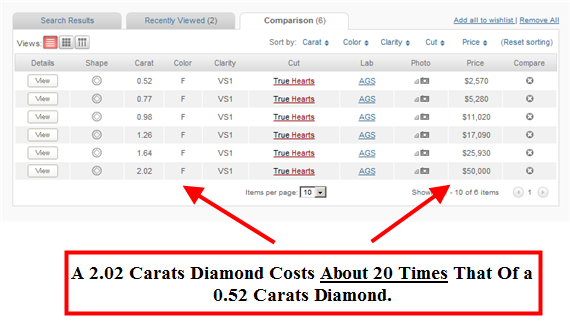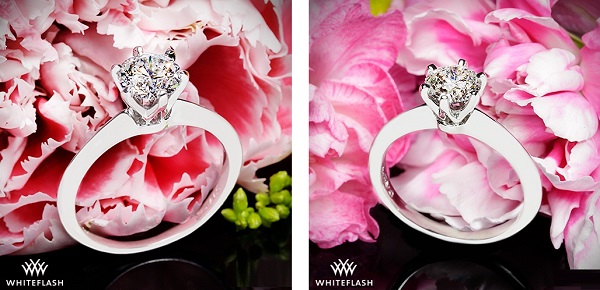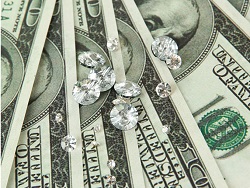How the Size of a Diamond Affects Pricing (Exponentially)

Here’s a fact: carat weight is the factor that has the largest impact on the price of a diamond.
Did you also know that more than 90% of polished diamonds are cut to maximize weight instead of optical performance? The simple reasons boil down to better economics and profitability for upstream businesses.
And that’s the ugly truth in today’s market.
You see, polishing a diamond to achieve better cut quality would require more effort and weight to be taken off the rough stone.
When faced with a decision to create a diamond that can sell for more money with less effort or to create a diamond with ideal proportions and incur more manufacturing costs, what do you think a cutter would do?
Well, I can tell you that the answer is pretty clear cut (pun-intended) when a profit-driven business is running the production line and plowing through a high volume of diamonds on a daily basis.
As a direct result of market driven forces, you can observe that the bulk of larger rough diamonds aren’t cut to ideal standards by intention. This is the reason why you see a lot of mediocre diamonds with exact 1.00 or 2.00 carat weights instead of truly well cut diamonds at 0.95 or 1.90 carat sizes.
Diamond Carat Weight And The Pricing System
The prices of diamonds do not rise linearly with their quality and size. Instead, prices have an exponential relationship with the carat sizes. For example, if a one carat diamond that is worth $7500, that doesn’t mean that a two carat diamond would be worth $15,000.
In fact, a two carat stone would cost significantly more than the sum of two individual one carat stones.
In contrast, two pieces of gold each weighing one kilogram is worth just as much as a single piece of gold weighing two kilograms. Diamonds, unlike gold, cannot be melted and shaped into any desired size and form.
Also, smaller roughs pop up more often during the mining process compared to roughs weighing hundreds of carats. For that reason, as the weight of the rough stone increases, their “price per carat” value rises exponentially.
Using a price list from JamesAllen.com as an example to illustrate this phenomenon, you can see that prices jump at every 0.25 carats in a non-linear fashion.

Bear in mind that the biggest price jumps occur at the half and full carat levels. If you are wondering why so many diamonds in the market are cut to exactly 1.00 carats or hitting the 0.50 mark accurately, here’s your answer.
Due to this pricing system, it also means that it is cheaper to buy a jewelry item that consists of multiple smaller stones instead of a single large diamond. If you are on a limited budget, this could be a good option to explore since each separate stone is priced individually rather than as a whole.
Carat Size May Dictate Prices But It Isn’t Everything
While a diamond with a larger carat weight may sound better on paper and helps you “show off” your status in society, it isn’t always about size. The carat weight of a diamond alone cannot be used as a fair reflection of its beauty in terms of sparkle and brilliance.
Think about this. What good is it to be wearing an insanely huge diamond ring when the stone itself resembles a frozen piece of spit because of terrible cut quality?
If you really need to hit a certain carat size because of personal preference and are working on a tight budget, my advice is to make compromises on the diamond’s color or clarity grade.
By lowering a couple of color or clarity grades (e.g. from F to a H color or VVS to a SI1 clarity) on the diamond, you get massive savings without eye visible changes to the diamond’s appearance.
1 carat F color diamond (left) vs 1 carat I color diamond (right)
Related Articles
Leave A Comment















2 Comments
If you can provide a diamond carat price calculator or chart for us to use, then it would be great. It can make the comparison between diamonds simple and convenient.
Thank you for your suggestion. What you said makes sense, but if you want to put this on Beyond4cs.com, then there is a certain technical difficulty in accessing real time data, because the price of diamonds often change. A price calculator can be very precise today, but it may not be accurate after 2-3 months. This applies to the charts or lists of diamond sizes and prices as well.
If you want to compare prices, the next link may help you: https://beyond4cs.com/diamond-prices/